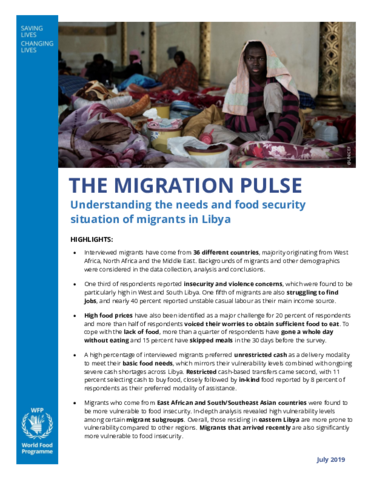
After a successful pilot in February 2019, the Migration Pulse interviewed 2,545 migrants inside Libya coming from 36 different countries through an innovative web survey. The data collected from January to May 2019 showed that:
- One third of respondents reported insecurity and violence concerns, which were found to be particularly high in West and South Libya. One fifth of migrants are also struggling to find jobs, and nearly 40 percent reported unstable casual labour as their main income source.
- High food prices have also been identified as a major challenge for 20 percent of respondents and more than half of respondents voiced their worries to obtain sufficient food to eat. To cope with the lack of food, more than a quarter of respondents have gone a whole day without eating and 15 percent have skipped meals in the 30 days before the survey.
- A high percentage of interviewed migrants preferred unrestricted cash as a delivery modality to meet their basic food needs, which mirrors their vulnerability levels combined with ongoing severe cash shortages across Libya. Restricted cash-based transfers came second, with 11 percent selecting cash to buy food, closely followed by in-kind food reported by 8 percent of respondents as their preferred modality of assistance.
- Migrants who come from East African and South/Southeast Asian countries were found to be more vulnerable to food insecurity. In-depth analysis revealed high vulnerability levels among certain migrant subgroups. Overall, those residing in eastern Libya are more prone to vulnerability compared to other regions. Migrants that arrived recently are also significantly more vulnerable to food insecurity.
| Document | File |
|---|---|
| Full Report [English] |
PDF | 695.53 KB
Download
|
